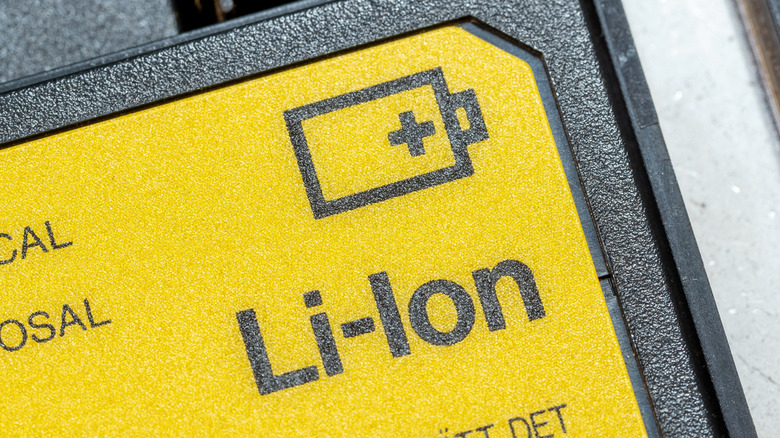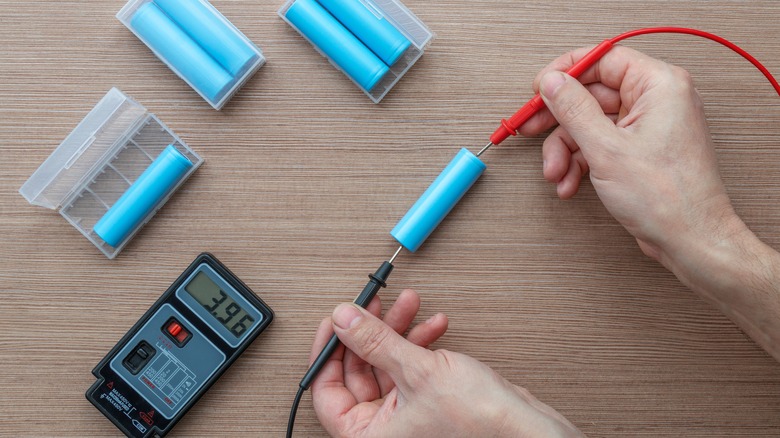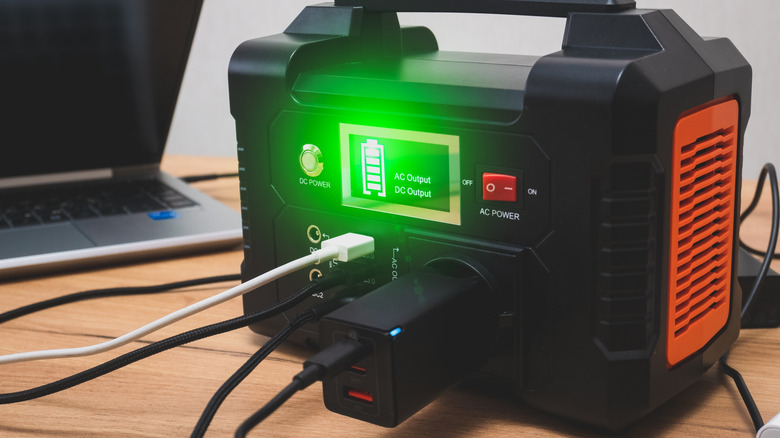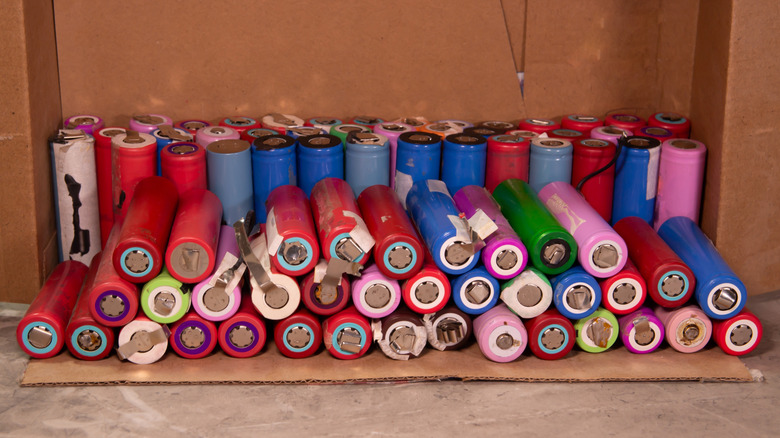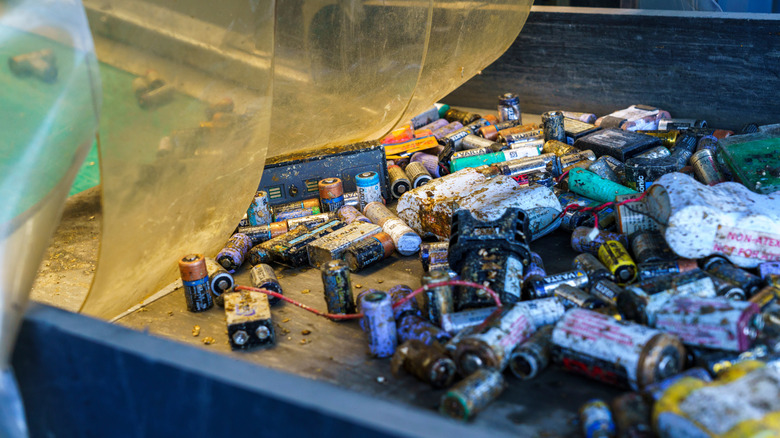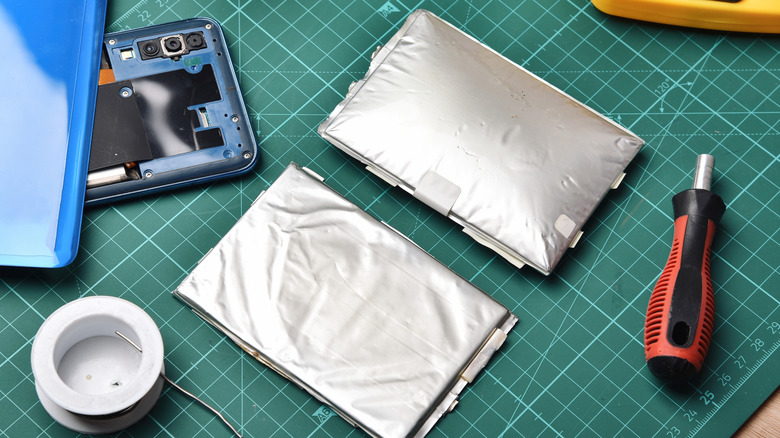All The Dangers You Should Know About Lithium-Ion Batteries (& How To Prevent Them)
It can be difficult to disentangle everything that contributes to panic, but we know that panic is often not the right reaction. In 2016, a major consumer advocacy publication reported that lithium-ion battery failures are less common, and are less likely at 1 in a million than your chances of being struck by lightning, which the National Oceanic and Atmospheric Administration put at around 13,000 to 1. But we've all heard stories of fires and explosions and, however likely they are, it's not how you want to spend an afternoon.
Still, it's important to get the context right. In a 1977 article titled "Pinto Madness," author Mark Dowie said that as many as 900 people might have burned to death in Ford Pintos. The National Highway Traffic Safety Administration put the number of deaths in the crashes in question at 27.
But however you cut it, the Pinto had some serious problems, and a one-in-a-million chance of your phone or electric shaver exploding in your face is one too many. Indeed, lithium-ion batteries have a tendency, sometimes caused by defects and sometimes by mishandling, of failing spectacularly. There are a lot of causes, but they all tie back to the battery technology's propensity for something called "thermal runaway," a refreshingly clear term for battery chemicals that get too hot, keep getting hot, then get out of control in the form of explosion or fire.
Only buy quality products from reputable sellers
Some of the problems are the result of misuse, but the core issues usually have to do with the specific lithium chemistry employed in a battery. Chemistries that include cobalt are more prone to thermal events, for example, but are still used. And before you complain, consider how much less power you want your phone to have or how much more slowly your EV should charge. Similarly, lithium-polymer batteries (those in rectangular plastic pouches) have the potential to be safer than hard-cased lithium-ion batteries, but aren't always. Decisions about battery chemistry and other design choices partly define the quality and safety of consumer products that make use of lithium-ion batteries. A few resources can help you unpuzzle the safety of lithium-ion-containing products. These include product recalls and listing by a national testing lab (like Underwriters Laboratories, as in "UL listed") that certify equipment as reasonably safe. These labs test products against predefined safety standards, usually having to do with factors like the possibility of electrical shock or fire. Passing the tests earns the product a listing and the right to use the testing lab's mark.
Product recalls are listed in the Consumer Product Safety Commission recall database, which you can consult before buying new or used goods. Recalls happen for a number of reasons. Sometimes the products' designs fail to meet federal safety standards or are simply found to be unsafe regardless of standards. We looked at 12 months' worth of recalls that contained the term "lithium-ion," and most were related to quality issues regarding battery management, affecting 3,601,055 consumer products.
If you treat them badly, they'll treat you worse
However foolproof manufacturers try to make their products, there's almost always a way to misuse them and create a hazard for yourself and your family. A product that's properly designed to manage lithium-ion batteries will typically involve protections against the sorts of problems that start the thermal runaway process, but safety mechanisms can't always keep up with the way we mistreat things. Some of these problems are very dangerous problems related to charging and storage; others are relatively minor issues that can, nonetheless, increase your risk of fire. For example, when using a product with removable lithium-ion batteries, be sure to use only the batteries designed for the device or described by the manufacturer as acceptable. It's also important to make sure you put the replaceable batteries into the product in the right orientation. If the manufacturer's instructions indicate that you should, take care to only use the charging cable that came with the product. It's generally a good idea to follow all of the manufacturer's instructions, if possible.
You should also make sure that any repairs you have done to a product are performed by a professional who's qualified to work with lithium-ion batteries. That includes repairing or building battery packs, which hobbyists sometimes do to save money. These battery packs often aggregate a number of individual cells that must be perfectly matched and monitored by a battery management system (BMS). Anyone who builds such a battery pack without the requisite knowledge might very well be building a time bomb.
Charging lithium-ion cells is often where things go wrong
For consumers, charging is usually a fairly straightforward affair: plug it in, then come back later. Some light will have gone off, or on, or changed color to indicate that charging is complete, and you're set for another cycle. But charging products made with lithium-ion batteries is a little more complicated. To manage the risk of thermal runaway, you must be sure to never charge such products where they might overheat (in a hot location, for example, or where heat won't be properly dissipated). You should also avoid charging products in places that can easily catch fire, such as on bedding or fabric furniture. Always use the charging equipment designated for the product by the manufacturer, which ideally came with the product.
If lithium-ion batteries make charging products more complicated, charging these batteries directly can be immensely more complicated. Just as battery management systems monitor batteries so they're not discharged too rapidly, lithium-ion charging systems must also monitor the charging process for overcharging, rate of charging, temperature, and other potential problems. If you're using a charger that you think might allow you to continue charging a lithium-ion battery after it is fully charged, you should discontinue its use immediately.
In fact, it's best to charge lithium-ion batteries outdoors, though it might not always be practical. Several of the products recalled for possible lithium-ion-related fire risks in the past 12 months specified that the risk was present during charging and resulted in battery overheating, so it's probably a good idea to monitor the temperature of charging lithium-ion devices periodically.
No place is 100% safe for battery storage
Because thermal runaway can be triggered by a high initial temperature, and because temperature can affect the safe operation of some battery chemistries, it's important to follow the manufacturer's recommendations and a few common-sense guidelines when storing lithium-ion products. Keep them at room temperature, if you can, and always above freezing but below 105 degrees Fahrenheit. Store them in a dry location, out of sunlight, and well clear of external heat sources like heaters and open flames. The ideal spot will also be well-ventilated (thermal runaway can release toxic gases) and without excessive humidity. Just in case, you should also store lithium-ion products away from anything flammable. That and the temperature extremes mean your garage might not be the best place to store spare batteries, including safely storing your mower batteries.
At this point you're probably thinking that your front lawn is going to be littered with USB chargers in air-conditioned tents so that your electric toothbrushes, phones, tablets, watches, flashlights, cameras, laptops, cordless drills, and that "hoverboard" your kid used one time don't set your house on fire. One resource we found advises that lithium-ion products be stored not only on non-flammable materials but also on a material with slots or holes that allow air to reach all sides, but not metal shelving, which can cause a short circuit. Such an overabundance of caution mostly applies to storing battery packs, not consumer products, which can mostly be stored safely indoors in moderate temperatures and away from heat sources. And, you know, not on top of a full gasoline can.
Lithium-ion batteries are a problem not easily disposed of
A few of the recalled products we examined were recalled for non-battery-related reasons, but mentioned lithium-ion batteries because consumers were required to dispose of them safely. And it's harder than you might think. We might have become accustomed to tossing the occasional alkaline battery in the trash, but disposing of lithium-ion batteries — or products containing lithium-ion batteries — with municipal waste is a serious problem and a direct danger to waste and recycling facilities. A 2021 EPA study of news reports found that 245 fires in 64 waste management facilities were attributed to lithium-ion batteries. These fires resulted in a range of results, from minor incidents with no real consequences to the complete destruction of facilities. The way waste is handled in materials recovery facilities (MRFs) — a mechanized, intentionally destructive process that often involves flammable items — is almost designed to trigger problems with lithium-ion batteries, which react poorly to such damaging handling.
As a result, there are a few key rules for disposing of lithium-ion batteries properly. First, don't throw them away with your garbage. Instead, your goal is to find the right place for them in the recycling stream. What, specifically, that means varies from area to area, so check with your local waste management department for instructions. But you should usually avoid simply putting lithium-ion batteries in your recycling bins, since that's where a majority of the problems identified by the EPA occurred. Instead, ask your waste department and local battery sellers how to recycle them. Most areas will have hazardous materials collection points, usually the best way to safely get rid of lithium-ion batteries.
How to know when a lithium-ion battery is on the brink
It can be difficult or impossible to see problems with lithium-ion batteries coming, especially if you can't see the batteries themselves. But for devices with removable — or at least visible — lithium-ion or lithium-polymer batteries, there are a few key things to be on the lookout for. If the battery is bulging or otherwise changing shape, those are usually signs of imminent danger. Any battery that is making a sound, smoking, changing color, or leaking can also be considered an immediate threat.
When lithium-ion batteries are sealed within consumer products, it can be difficult to see potential signs of trouble. Keep a lookout for the sights and sounds that might be associated with battery problems, including visible smoke or any unusual odor. And heat is an obvious red flag; if a product feels hot to the touch in a way that it normally does not, proceed with great caution.
Even if it's not exhibiting any of these problems, a battery that is visibly damaged should be treated as if it might catch fire at any moment. The structure of lithium-ion batteries includes features like sealed cases, protective overwraps, and integrated circuitry that can fail immediately or soon after any damage occurs. Get such a battery or product out of your home if you can safely do so, and if you can't, call the fire department for assistance and instructions.
